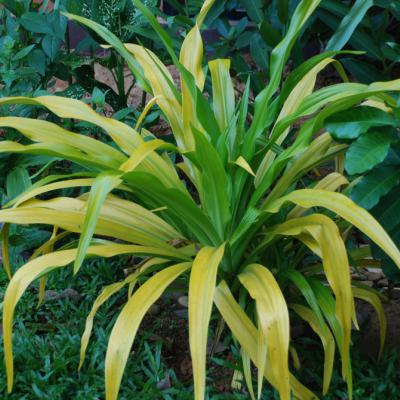Amaryllidaceae-Crinum-zanthophyllum
Classification
- Botanical Family : Amaryllidaceae
- Genus : Crinum
- Epithet : zanthophyllum
- German Family Name: Amaryllisgewächse
- English Name: Poison Bulb, Golden Swamp Lily
- Thai Name: พลับพลึงทอง
- Thai Phonetic: plap plüng tong
- Author: L.S.Hannibal
Water Requirements
Plant Type
Light Requirements
Cultivation
Crinum zanthophyllum is a synonym of Crinum asiaticum var. asiaticum
The plant is very similar toCrinum asiaticum, but Crinum zanthophyllum is in its natural height slightly smaller (up to 1,50 m) and the leaves are green and golden yellow at the leaf ends. That makes them as a very interesting appearence in the garden. Particularly in coastal areas, the leaves are very bright in color.
The flowers are white, delicate fragrant and are arranged in clusters at the end of thick, juicy stems. They bloom in the summer months during the rainy season.
Crinum zanthophyllum grows in any well-drained soil, but the growth rate is slow. The plant does well in any soil. For an abundant flowering a full sunny location is preferred or a light shade. The plant has an average water demand. The soil should not dry out.
Crinum zanthophyllum looks best as free-standing group. It also does very well in combination with Hymenocallis littoralis at pond edges, or on the banks of waterstreams where space allows. The plants can stand there in the mud, but not in the water.
The plant could used like sculpture to create a focal point in the garden or in an expanse of lawn. This big plant looks great with palm trees too. As a container plant and in small gardens it is because of their large size limited use.
All parts of the plant are poisonous. The sap can cause skin irritation. Causes stomach aches and nausea when the plant is consumed.
Propagation: dig up a clump and separate the small offset bulbs from the parent bulb. Plant these in pots or directly in the garden where they will quickly root to form new plants. The constantly forming new young shoots let grow the plant wider and bushier after a certain time. If this is not desired, remove the new shoots.
Crinum zanthophyllum ist ein Synonym von Crinum asiaticum var. asiaticum.
Die Pflanze ist Crinum asiaticum sehr ähnlich, jedoch ist Crinum zanthophyllum in seiner Wuchshöhe etwas kleiner (bis 1,50 m) und die Blätter sind grün und an den Blattenden goldgelb. Das macht sie zu einer sehr interessanten Erscheinung im Garten. Besonders in Küstennähe sind die Blätter besonders hell in der Farbe.
Die Blüten sind weiß, duften zart und sind in Büscheln am Ende von dicken, saftigen Stängeln angeordnet. Sie blühen in den Sommermonaten während der Regenzeit.
Crinum zanthophyllum wächst in jeder gut durchlässigen Erde. Die Wachstumsrate ist eher langsam. Einen besonderen Anspruch an den Bodentyp stellt die Pflanze nicht. Für eine reichliche Blütenbildung wird ein voll sonniger Standort bevorzugt. Gedeiht aber auch in hellem Halbschatten. Die Pflanze hat einen mittleren Wasserbedarf. Das Erdreich sollte aber möglichst nicht austrocknen.
Crinum zanthophyllum kommt am besten als freistehende Gruppe oder Einzelpflanze zur Geltung. Sie sieht aber auch zusammen mit Hymenocallis littoralis an Teichrändern, Pools oder am Ufer von Wasserläufen sehr hübsch aus, wenn es der Platz erlaubt. Die Pflanzen können dort im Morast stehen jedoch nicht im Wasser. Die Pflanze kann auch wie eine Skulptur verwendet werden, um einen Fokus Punkt im Garten oder in einer Rasenfläche zu schaffen. Diese große Pflanze sieht auch toll in Kombination mit Palmen aus. Als Kübelpflanze und in schmalen Gärten ist sie auf Grund ihrer Größe nur bedingt geeignet.
Alle Teile der Pflanze sind giftig. Der Saft kann Hautirritationen hervorrufen. Verursacht Magenverstimmung und Übelkeit, wenn die Pflanze verzehrt wird.
Vermehrung: Jungtriebe entwickeln sich aus der Mutterpflanze, die abgelöst werden und direkt an einen neuen Ort in gut durchlässige feuchte Erde gepflanzt werden können. Die sich ständig neu bildenden Jungtriebe lassen die Pflanze nach einer gewissen Zeit immer breiter und buschiger werden. Ist dies nicht gewünscht, die neuen Triebe einfach abstechen und somit die Pflanzengruppe ausdünnen.


